|
Learn.Network.Together.
Leave No Trace eNews June 2009
|
|
BECOME A MEMBER
|
JOIN
Leave No Trace Today!
|
Already A Member?
|
It's Easy & Quick to RENEW
|
Quick Links
|
DONATEto Support or Join the Bigfoot Challenge!
|
|
|
"There is no such thing as bad weather,
just bad clothing"
I overheard this walking down my street, of all places, the other morning, and had to smile. Colorado is notorious for quickly changing weather, but some things like afternoon thundershowers in the summer are fairly predictable.
I might even take this statement a little further and substitute "bad planning" for "bad clothing". Every season can be enjoyable when you have the right gear, clothing and backup options. Personally, some of my favorite trips and experiences have been in what some would consider "bad weather". I have found that often our environment is revealed in totally new and unique ways during different weather conditions.
A quick look at the forecast, and a little research as to the typical conditions for a given area and season can make or break a trip or even a day out. If traveling somewhere new, stop in the local Outdoor Retailer and ask the local experts what to expect. So even if the "weather" doesn't cooperate, be able to make the most of every trip on your list this year, and enjoy!
Kurt Achtenhagen
Finance Director
|
|
|
My Backyard
|
|
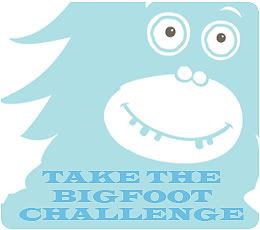 The Challenge Begins: The Challenge Begins:
Can You Leave No Trace Like Bigfoot?
If you haven't heard, Bigfoot has recently teamed up with us to honor the 10th Anniversary of the Subaru/Leave No Trace Traveling Trainer Program.
We would like to thank you for helping us bring Leave No Trace workshops, training and outreach to your community. Since January of 1999, thirteen different teams have hit the road, traveling coast to coast, teaching over 10 million outdoor users how to enjoy the outdoors responsibly.
Help us celebrate education in motion by taking the Bigfoot Challenge this year! By visiting www.lnt.org/bigfootchallenge or catching up with the Traveling Trainers at an event this summer, you have a chance to take part in the Leave No Trace Bigfoot Challenge.
By participating in the challenge, you're not only entered to win some great outdoor prizes from our partners, but you will help us continue Leaving No Trace just like Bigfoot has been doing for years!
|
eNews You Can Use
|
|
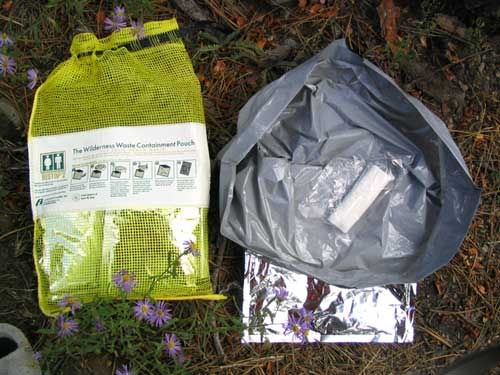 Dear Education Department, Dear Education Department,
I just went canyoneering for the first time a couple weeks ago and while we were in there we were wondering just how exactly one goes to the bathroom in a canyon. Is there any other answer besides a Wagbag?
It might sound lame that I don't want to carry it out, but I might as well ask if there are other options.
Thank you for your time.
Signed,
Grossed Out
*****
Dear Grossed Out,
First and foremost, we always recommend adhering to the land managers rules and regulations, particularly those pertaining to disposal of human waste in sensitive environments such as desert canyons. We also encourage recreationists to always consider using the lowest impact practices possible when enjoying the out of doors.
I know that the idea of packing out your human waste can be fairly (to completely) unpalatable but there is no doubt that it leaves the least impact of any other method of disposing of human waste. Both WAG Bags and Restops are both very sanitary options for packing out your human waste. 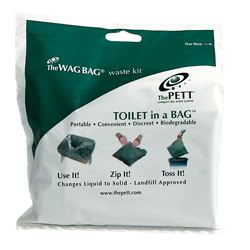
I use these on river trips in the arid west and have found them to be a great product for dealing with what could be a very unpleasant proposition. I'd encourage to you give some thought to the impact that you leave behind which will undoubtedly impact other people, water, wildlife or all of the above. If you really enjoyed the place you went canyoneering and you like the thought of it staying in the same (or better) condition as when you first visited, think about how you can minimize your individual impact the next time you venture out.
Our general guidance for proper human waste disposal in desert canyon environments is as follows - Proper human waste disposal will allow you to:
· Avoid polluting water Sources
· Eliminate contact with insects and animals
· Maximize decomposition
· Minimize the chances of social impacts
Improper disposal of human waste can lead to water pollution, the spread of illnesses such as giardia, and unpleasant experiences for those who follow.
Facilities/outhouses. Whenever possible, take time to locate and use bathrooms, outhouses, and other developed sites for human waste disposal.
Cat holes. If no facilities are available, deposit solid human waste in cat holes dug 6 to 8 inches deep at least 200 feet from water, camp,trails, and drainages. Look for organic soil under trees and away from cryptobiotic soil crusts for your cat hole site. Bring a trowel to dig the hole, and disguise it well before leaving. Ideally, the microbes found in soil break down feces and the pathogens they contain, but in the desert, this process happens very slowly, so make sure your cat hole site is well-hidden and buried deeply so it won't be uncovered accidentally. Don't leave human waste under rocks or in alcoves because it will decompose slowly there. If the cat hole method is ill suited to your group, it's best to camp where an outhouse or pit toilet is available. Good cat hole sites isolate waste from water sources such as lakes, streams, dry creek beds, ravines, potholes, and other visitors. Whenever possible, use a remote location during the day's hike to help prevent high concentrations of cat holes near campsites.
Toilet paper. Plan ahead to pack out used toilet paper in a plastic bag. This practice leaves the least impact on the area. Packing soiled toilet paper with baby wipes deodorizes the trash bag, and the wipes help you stay cleaner. Double bagging your trash prevents any accidental contamination. Burying toilet paper in the desert is not recommended. The arid environment preserves paper-newspapers from the 1870s that were used to insulate mining cabins in the desert are still legible today. Burning toilet paper at the site is also not recommended both because it is hard to burn the paper completely and because the practice has caused wildfires. Natural toilet paper such as grass, river rocks, sticks, and snow can be surprisingly effective. If you choose to use natural toilet paper, bury it in your cat hole. Always pack out feminine hygiene products because they decompose slowly and attract animals. If you do not believe your group is capable of packing out toilet paper hygienically, your only option may be to instruct everyone to bury it in their cat holes. If you choose this option, be particularly diligent about digging down deeply enough to prevent scavenging animals from excavating the contents.
Carrying waste out. Often, visitor use is high and soils sparse in desert areas. Recreation managers seeking to protect human health and water sources employ a spectrum of toilet designs and approaches to managing human waste-even airlifting such waste out with helicopters. There are a number of products available now for packing out your own feces. One effective, low-cost option is to carry and use a homemade poop tube or to purchase a device designed specifically for transporting human waste. Some of these products allow you to dispose of human waste in landfills or trash cans, others need to be deposited in pit toilets or porta-johns. Check with local land managers or the Leave No Trace Center for Outdoor Ethics for information about these products and other appropriate disposal techniques for human waste.
Sincerely,
The Education Department
|
Partnership Highlight
|
|
New Zealand Forms Leave No Trace Organization
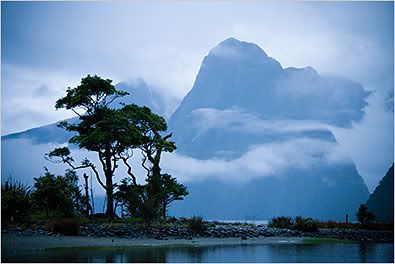 A couple of weeks ago, the Leave No Trace Center for Outdoor Ethics completed work with a committee of educators, Non-Governmental Organizations, representatives from government agencies, scientists and other leaders to create Leave No Trace New Zealand. The group, led by Chris North from the New Zealand Alpine Club and the University of Canterbury College of Education, contacted Leave No Trace three years ago to begin discussion about forming a Leave No Trace organization there. A couple of weeks ago, the Leave No Trace Center for Outdoor Ethics completed work with a committee of educators, Non-Governmental Organizations, representatives from government agencies, scientists and other leaders to create Leave No Trace New Zealand. The group, led by Chris North from the New Zealand Alpine Club and the University of Canterbury College of Education, contacted Leave No Trace three years ago to begin discussion about forming a Leave No Trace organization there.
North describes that while the importance of environmental care is understood by many New Zealanders, the country has multiple and sometimes conflicting environmental care codes. The multitude of codes give general instructions but are rarely explained further: specifically, the how to, what, and why.
North also sites an increasing number of people using the New Zealand outdoors from overseas that are unfamiliar with the unique elements of the local environment and how to take care of it. The lack of a unified approach to outdoor skills and ethics, combined with his work with the Leave No Trace program while living in the United States, inspired him to mobilize the people and resources to form a Leave No Trace organization in New Zealand.
North and his colleagues at Leave No Trace New Zealand will be operating as volunteers for the next several months, developing the infrastructure, partnerships and introductory materials to introduce the program to the general public.
For more about Leave No Trace's international programs please visit: http://lnt.org/support/international.php
To learn more about our partnership community and opportunities, visit our Partnership web page or contact Sara.
|
|
Road Wisdom |
|
Contributed by Tracy Howard and Kate Bullock
Subaru/Leave No Trace Traveling Trainers
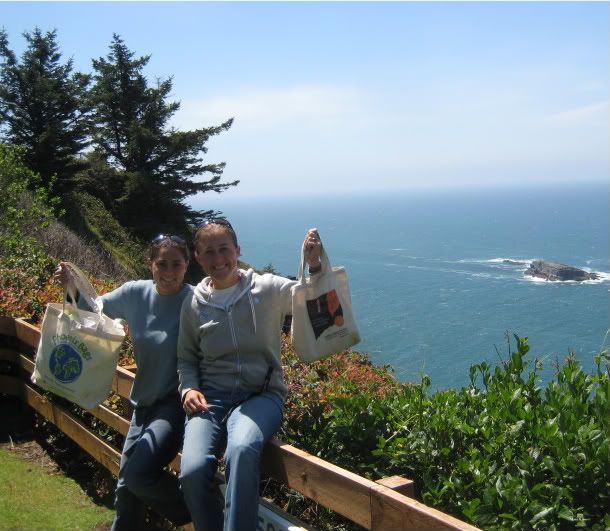 Ditch the Plastic Bags! Ditch the Plastic Bags!
As we criss-cross the country, there is an unfortunate common theme along our country's roadsides...TRASH. Plastic bags are one of the more regularly seen eyesores. Aesthetic impact aside, the negative environmental impact is substantial. Here are some staggering facts about plastic bags:
- Each year, an estimated 500 billion to 1 trillion plastic bags are consumed worldwide. That comes out to over one million per minute. Billions end up as litter each year.
- Plastic bags don't biodegrade, they photodegrade - breaking down into smaller and smaller toxic bits contaminating soil and waterways and entering the food web when animals accidentally ingest.
- Hundreds of thousands of sea turtles, whales and other marine mammals die every year from eating discarded plastic bags mistaken for food.
- According to the EPA, over 380 billion plastic bags, sacks and wraps are consumed in the U.S. each year.
Leave No Trace is about small changes that make a big difference. In this instance, it is easy to make a HUGE difference by using reusable shopping bags. So whether you are meeting friends for a picnic in the park, buying supplies for your next outdoor adventure, or heading out for some fresh veggies at the local farmers market be sure to bring along your reusable sack.
TIP: Store your reusable bags in your car, so they will be on hand each time you shop.
For more facts and solutions on plastic bags, please visit the website www.reusablebags.com
While you are out enjoying the summer, be sure to do you part to dispose of waste properly. Better yet, create less waste by toting your reusable bags along with you!
Safe Travels,
Tracy and Kate
Subaru/Leave No Trace Traveling Trainerrs
|
|
 T-Shirt Sale! T-Shirt Sale!
Just in time for Summer, Leave No Trace T-Shirts are on Sale! Get yours today so you can enjoy it all summer. These great 100% organic cotton shirts have the Leave No Trace logo on the left breast and back, and are available in Navy, Green and Charcoal. And they are a screaming deal at $12 each, or $14.60 for the 2XL and 3XL sizes.
|
|
ATTENTION MEMBERS & PARTNERS!
|
|
Moved? Moving?
Changing things up?
Please keep your email and mailing addresses current!
Learn.Network.Together.
is another step the Center is making toward a more consistent online communication for our community, in an effort to conserve resources and our planet! Please help us by e-mailing info@LNT.org to update your records.
|
|
|